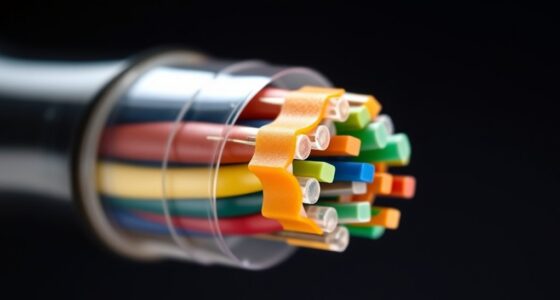When choosing an Ethernet cable gauge (AWG), consider your project’s distance, data load, and installation environment. Thicker cables (lower AWG like 22) offer better signal quality and durability for long runs, while thinner ones (higher AWG like 26) are more flexible and easier to install in tight spaces. Balancing flexibility, strength, and cost is key. Keep in mind the environmental needs and standards to guarantee reliable performance—learn more to find the best fit for your setup.
Key Takeaways
- Select lower AWG (thicker wire) for longer distances and higher data loads to reduce signal loss.
- Use higher AWG (thinner wire) for flexibility and tight-space installations over short distances.
- Consider environmental factors; outdoor or high-wear settings may require more durable, thicker cables.
- Balance project budget with quality needs; investing in appropriate gauge improves performance and longevity.
- Ensure cable standards and compatibility with your devices to maintain safety and optimal network performance.
Understanding What AWG Means in Ethernet Cables
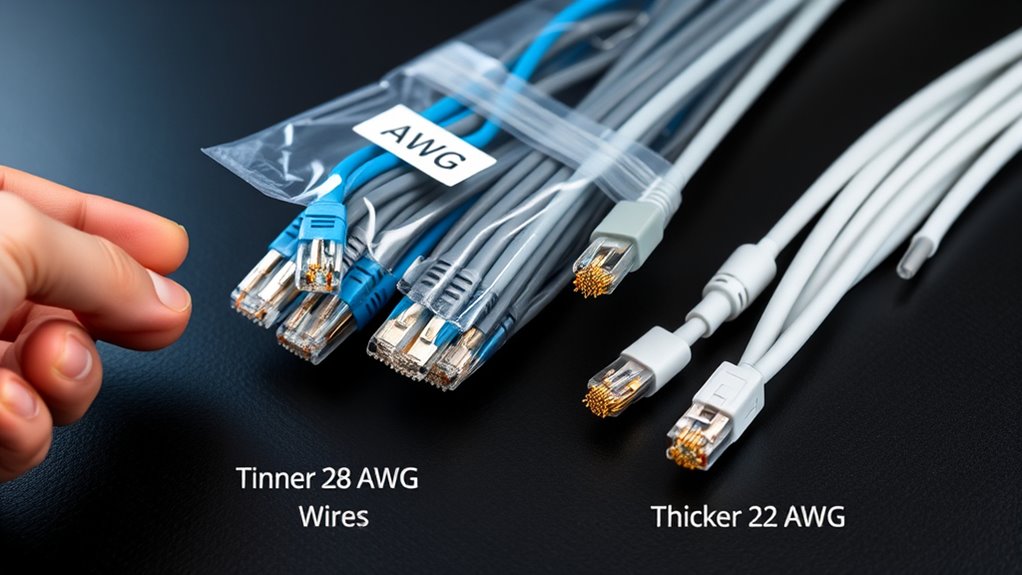
Understanding what AWG means in Ethernet cables is essential because it directly affects their performance and suitability for your network. AWG, or American Wire Gauge, measures the thickness of the cable’s conductors. Thicker wires, like those with lower AWG numbers, can carry more current and reduce signal loss over longer distances. This impacts your network’s stability and speed. When evaluating cables, consider the twisted pair design, which helps minimize interference, and shielding options that protect against external noise. Shielding, such as foil or braided shields, enhances signal integrity, especially in noisy environments. Knowing the AWG helps you select a cable with the right balance of flexibility, durability, and performance for your specific needs. Additionally, selecting the appropriate AWG can influence the cable’s overall nutritional value of juices, ensuring reliable and efficient network performance. Being aware of cable construction features can further improve your choice for specific applications, especially when considering signal attenuation and its effects over distances. Proper understanding of wire gauge can also help prevent issues like overheating and signal degradation, especially in high-power or long-distance setups.
How Cable Thickness Affects Signal Quality and Performance
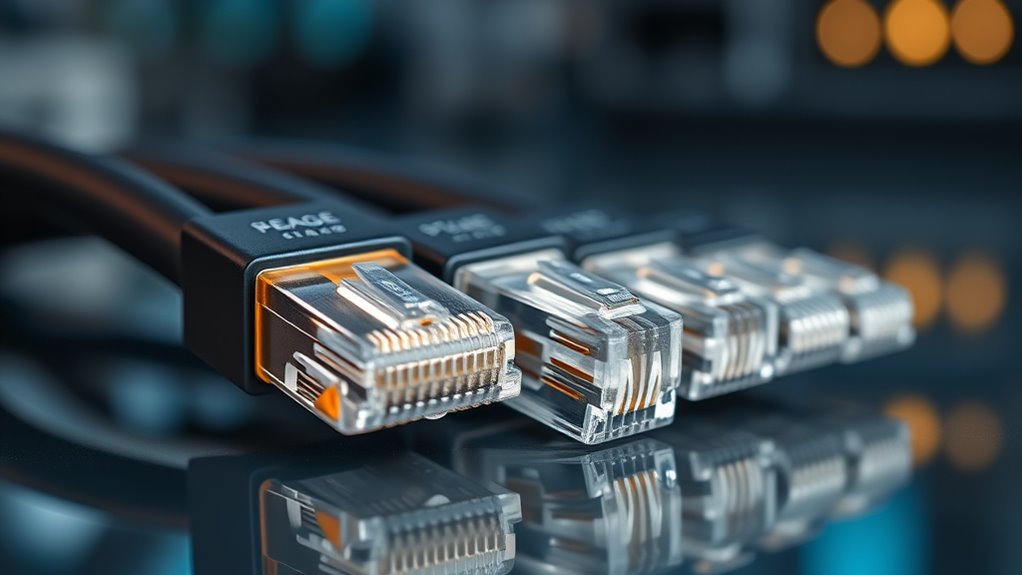
Thicker Ethernet cables, which have lower AWG numbers, generally deliver better signal quality and performance over longer distances. Their increased cable insulation reduces interference, ensuring a clearer connection. The thicker gauge also minimizes signal loss, making your network more reliable. Color coding helps you quickly identify cable types and gauges, reducing setup errors. Keep in mind, however, that bulkier cables can be less flexible. Proper cable management ensures safety and efficiency in your installation. To evoke emotion, consider this table showing cable benefits:
| AWG Size | Signal Strength | Flexibility | Insulation Quality |
|---|---|---|---|
| 22 AWG | Stronger over distance | Less flexible | Superior insulation |
| 24 AWG | Good for short runs | More flexible | Standard insulation |
| 26 AWG | Suitable for low power | Very flexible | Basic insulation |
Choosing the right gauge balances performance and ease of installation. Additionally, understanding cable gauge helps optimize your network setup for both reliability and convenience.
Common AWG Sizes Used in Ethernet Cabling

Common AWG sizes used in Ethernet cabling typically range from 22 to 26 AWG, with each size serving different needs. Thicker cables, like 22 AWG, offer better signal quality for long runs and are less susceptible to interference, similar to fiber optics’ reliability. Thinner options, like 26 AWG, are more flexible and easier to install, making them ideal for short distances or tight spaces. As wireless alternatives grow, understanding these sizes helps you decide when cable quality matters most. Consider these points: 1. Thicker cables reduce noise and improve stability. 2. Flexibility is higher in thinner gauges for complex setups. 3. Fiber optics provide high-speed data transfer, but Ethernet cabling remains crucial. 4. Matching AWG to your project ensures excellent performance and future-proofing. Additionally, selecting the appropriate cable gauge can significantly impact overall network reliability and performance. Recognizing the appropriate gauge for your specific environment ensures optimal performance and longevity of your network infrastructure, especially when considering signal integrity in critical applications.
Choose the right AWG size for optimal Ethernet performance and installation flexibility.
A well-chosen gauge also helps maintain consistent data transmission, ensuring your network remains stable over time.
Factors to Consider When Choosing the Right AWG for Your Network

When choosing the right AWG for your network, you need to take into account your signal strength needs to ensure reliable data transmission. Flexibility might also matter if your setup requires bending or moving the cable frequently. Additionally, your budget can influence which gauge options are practical for your installation. Considering wall organization systems can help in managing cable routing and maintaining an organized space. Choosing the appropriate cable gauge can also impact the overall durability and longevity of your network setup. Evaluating cable insulation options can further enhance performance and protection against environmental factors, especially when considering the potential effects of environmental exposure on skin contact and safety.
Signal Strength Demands
Choosing the right AWG for your network depends heavily on the signal strength you need to maintain over your cable runs. Longer distances or high data loads demand thicker cables to reduce signal loss. If your project requires consistent, high-quality connections, thicker gauge cables ensure stronger signals. Consider these factors:
- Will you need to cover vast distances where fiber optics might be more reliable?
- Are wireless alternatives sufficient for your environment, reducing the need for ultra-strong Ethernet signals?
- Is your network handling sensitive or high-bandwidth data that demands minimal attenuation?
- Do environmental factors threaten signal integrity, making a more robust cable necessary?
Matching your AWG to your signal strength needs prevents data degradation and future-proofs your setup, especially when knowing fiber optics or wireless options are also on the table.
Cable Flexibility Needs
Flexibility is a crucial factor when selecting the right AWG for your network because it directly affects how easily the cable can bend and maneuver through tight spaces. Thinner cables with higher AWG numbers generally offer greater flexibility, making installation easier in complex setups. Consider the cable insulation, as thicker or more rigid insulation can reduce flexibility, complicating installation challenges. If your project involves routing through crowded or confined areas, choosing a more flexible cable can save time and effort. Conversely, lower AWG cables tend to be stiffer, which might be necessary for durability in harsher environments but can make installation more difficult. Balance your need for cable flexibility with the cable’s insulation properties to ensure smooth installation and reliable performance. Additionally, understanding the cable gauge can help you select a wire that offers the optimal combination of flexibility and durability for your specific application. Proper cable management techniques can further enhance the ease of installation and long-term performance of your network cables. For optimal results, consider material options that influence both flexibility and durability based on your project requirements.
Budget Constraints
Budget constraints play a significant role in determining the appropriate AWG for your network. You want to find options that balance quality with affordability. Consider these factors:
- Prioritize budget-friendly options that don’t sacrifice essential performance.
- Seek cost-effective solutions that fit within your financial limits without risking future issues.
- Compare prices across brands to find reliable, affordable cables.
- Remember, sometimes investing a little more upfront saves you money long-term by reducing maintenance or replacement costs.
- Be mindful of relationship dynamics that can affect your decision-making process, ensuring you choose the best option for your needs.
- Additionally, understanding the design elements of a farmhouse bedroom can help you select the right aesthetic and functionality for your space. Incorporating knowledge about sound healing practices can also guide you in choosing cables that minimize interference for clearer signals. Considering the insulation quality of the cable can further enhance performance by reducing signal loss and interference.
Sticking to your budget doesn’t mean settling for less. With smart choices, you can select a gauge that offers reliable performance and fits your financial constraints, ensuring your network runs smoothly without overspending.
The Relationship Between AWG and Cable Flexibility
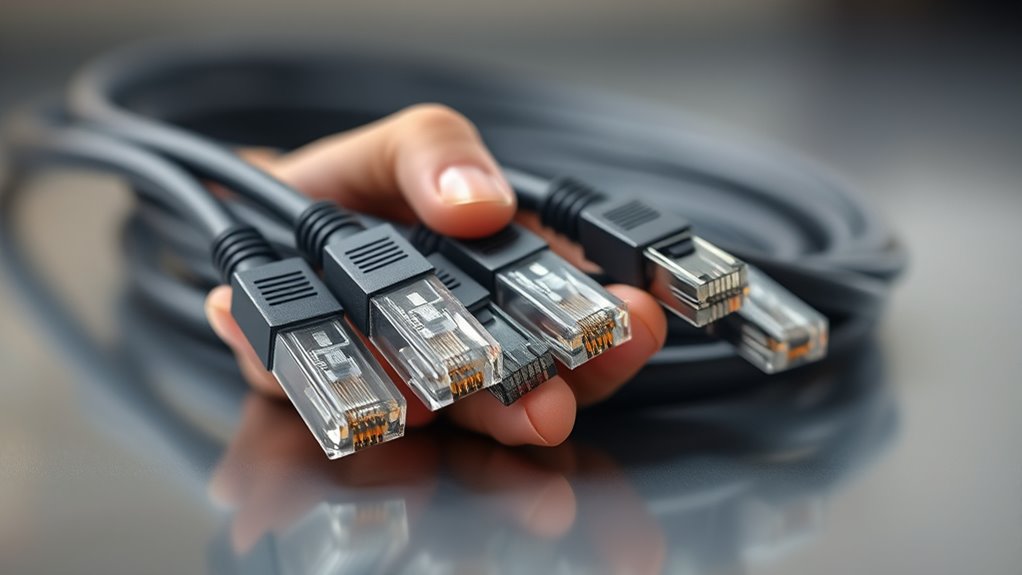
As the gauge of an Ethernet cable decreases, its flexibility tends to increase, making it easier to bend and install in tight spaces. Thinner cables are more adaptable, which benefits installation techniques that require maneuvering around obstacles. Keep in mind that cable insulation also influences flexibility; softer insulation enhances bendability without compromising protection. Use the table below to compare different AWG sizes and their flexibility:
| AWG Size | Flexibility Level |
|---|---|
| 24 AWG | Most flexible, ideal for tight bends |
| 22 AWG | Moderately flexible, good balance |
| 20 AWG | Less flexible, suitable for straight runs |
| 18 AWG | Least flexible, more rigid but durable |
Choosing the right AWG depends on your needs, balancing flexibility with cable insulation for optimal installation. Understanding the differences in cable gauge can help ensure you select the appropriate cable for your specific project requirements.
Durability and Environmental Considerations for Different AWG Sizes

Larger AWG sizes, such as 18 and 20, tend to be more durable and resistant to physical damage, making them suitable for environments with higher wear and tear. They often offer better weather resistance, standing up to moisture, sunlight, and temperature fluctuations. When considering durability, think about installation ease—thicker cables can be more flexible, easing setup in tight spaces. To help you decide, consider these factors:
- Weather resistance ensures your cable withstands outdoor elements without degradation.
- Physical durability reduces the risk of damage from handling or environmental stress.
- Installation ease can be greater with thicker AWG cables, simplifying setup.
- Long-term resilience saves you money on replacements and repairs.
Choosing the right AWG for durability and environmental needs guarantees your network stays reliable.
Compatibility and Standards for Ethernet Cable AWG

When selecting an Ethernet cable, it’s crucial to check if it meets industry standards and is compatible with your equipment. Ensuring compliance helps you avoid connectivity issues and guarantees reliable performance. Always verify that the cable’s AWG size aligns with your device’s specifications for the best results.
Industry Standards Compliance
Ensuring your Ethernet cable meets industry standards is essential for compatibility and peak performance. Understanding wire gauge history helps you appreciate the evolution of standards, guaranteeing your choices align with proven benchmarks. When comparing copper Ethernet cables to fiber optic options, standards ensure reliable data transfer regardless of gauge or material.
Here are four reasons standards matter:
- Safety First – Standards prevent hazards and ensure durability.
- Interoperability – Compatibility across devices and networks guarantees seamless connections.
- Performance Assurance – Certified gauges meet specific data and power requirements.
- Future-Proofing – Following evolving standards keeps your setup relevant and reliable.
Compatibility With Equipment
Choosing the right Ethernet cable gauge is essential because not all gauges are compatible with every type of networking equipment. Your devices and network standards determine which gauge works best. For instance, some equipment supports standard copper cables, while others are designed for fiber optics connections, which require different specifications. If your setup includes fiber optic links or uses wireless alternatives, verify the cable gauge matches the device’s requirements to prevent connection issues. Using an incompatible gauge can lead to signal loss or reduced performance. Always check your equipment’s compatibility and standards before selecting a gauge. This will help you avoid future problems and ensure reliable, high-quality network performance tailored to your specific setup.
Practical Tips for Selecting the Optimal AWG for Your Setup
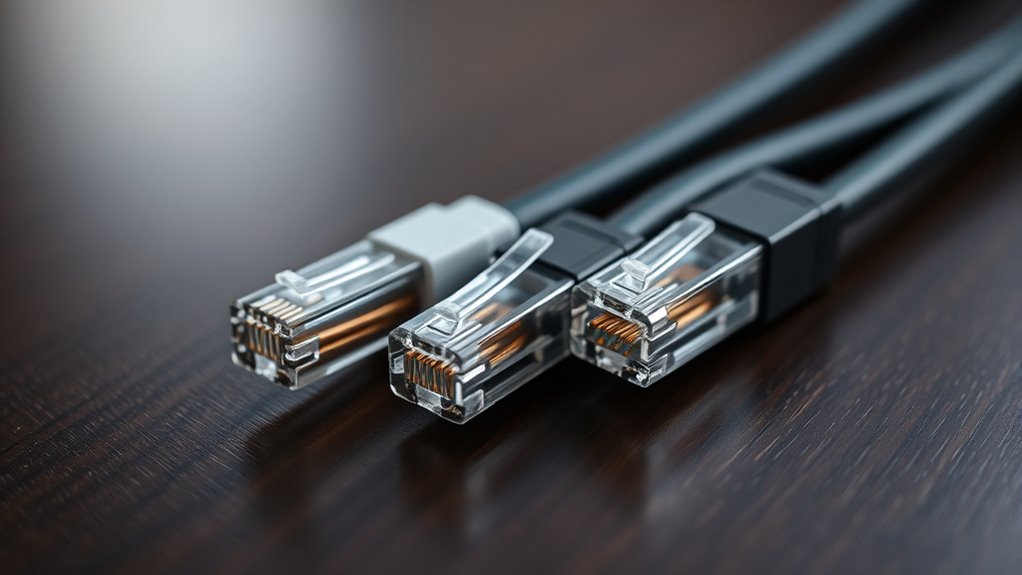
Selecting the right AWG for your Ethernet setup depends on understanding the specific needs of your network. Consider the distance, speed requirements, and environment to choose the best gauge. For instance, thicker cables like 22 AWG can handle longer runs and higher power, reducing signal loss. If you’re exploring fiber optic or wireless alternatives, keep in mind that certain AWG sizes may enhance performance or compatibility. Here are practical tips:
- Assess your distance needs—longer runs often need thicker gauge cables.
- Prioritize speed and bandwidth—thinner cables can support high speeds over shorter distances.
- Evaluate environmental factors—exposure to interference might demand shielded cables.
- Balance flexibility and durability—thicker gauges are sturdier but less flexible.
Choosing wisely ensures a reliable, future-proof network tailored to your unique setup.
Frequently Asked Questions
How Does AWG Impact the Maximum Cable Length I Can Use?
You’ll find that a thicker AWG, like 22 or 24, reduces cable resistance and signal attenuation, allowing you to use longer cable runs without losing quality. Thinner cables, such as 26 or 28 AWG, increase resistance and attenuation, limiting maximum length. So, selecting a proper gauge directly impacts how far you can extend your Ethernet cable before signal degradation affects performance.
Are Thicker Cables More Resistant to Electromagnetic Interference?
Thicker Ethernet cables generally resist electromagnetic interference better because of improved shielding effectiveness and higher conductivity differences. The increased gauge provides more material to block interference and reduce signal degradation. You’ll find that these cables are more resistant to external noise, ensuring a clearer, more reliable connection. So, if electromagnetic interference is a concern, opting for a thicker cable with better shielding can markedly improve your network’s performance.
Can I Mix Different AWG Sizes Within the Same Network?
You can mix different AWG sizes within the same network, but it’s not recommended. Doing so can affect cable flexibility and make installation trickier. To avoid confusion, use color coding to differentiate cable gauges, and guarantee all connections are compatible. Mixing gauges might cause signal loss or performance issues, so plan carefully and keep track of each cable’s gauge to maintain ideal network performance.
How Does AWG Choice Affect Cable Installation Costs?
Choosing the right AWG is like picking the right tool for a job; it can substantially impact your costs. Thicker cables (lower AWG) usually cost more and are harder to install, increasing complexity. A careful cost comparison shows that smaller gauges may save money upfront but could cause issues later. Optimizing your AWG choice balances installation ease and overall project costs, helping you avoid unexpected expenses down the line.
What Are the Safety Considerations for Higher AWG Gauge Cables?
When using higher AWG gauge cables, you need to consider safety carefully. Thicker cables reduce fire hazards by handling more current safely, but verify the insulation integrity remains intact to prevent short circuits or overheating. Always verify that your cables meet safety standards, and avoid overloading them. Proper installation and quality insulation protect against potential fire risks, ensuring your project stays safe and reliable.
Conclusion
Think of choosing the right Ethernet cable gauge as selecting the perfect paintbrush for your masterpiece. The right AWG guarantees your network runs smoothly, like a steady brushstroke, without damaging your project’s quality. By understanding the differences and considering your specific needs, you’ll find the ideal size that balances performance, flexibility, and durability. With the right choice, your network setup will be as flawless as a well-crafted painting.





